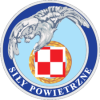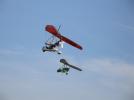Jet2 B733 at Leeds on Aug 2nd 2013, electrical failure and burning smell
A Jet2.Com Boeing 737-300, registration G-CELF performing flight LS-201 from Leeds,EN (UK) to Amsterdam (Netherlands) with 119 passengers and 5 crew, was climbing out of Leeds' runway 14 with the first officer flying the aircraft and the captain (56, ATPL, 8,130 hours total, 3,300 hours on type) being pilot monitoring, when the captain heard a click sound and noticed the autothrottle had disconnected. Subsequently the Master Caution and FLT CONT indication activated indicating the Mach trim had failed. At the same time the commanders electronic ADI, HSI, Altimeter, VSI, Mach and radio altimeter failed, the #1 rectifier transformer unit circuit breaker tripped, the flight management computer locked up with both CDUs becoming unresponsive. The right hand instruments remained all functional except for the flight track (from the FMS) no longer being displayed on the navigation display and crosschecked with the stand by instruments. The crew continued to retract gear and flaps and at safe height levelled off at 4000 feet. The captain checked the condition of the electrical systems, detected that yaw damper, left forward window overheat, a fuel pump and normal exhaust fan were also inoperative. The circuit breakers for battery charger, electric hydraulic pump B and normal exhaust fan had tripped in addition. The commander started the APU, called the purser to the flight deck for a briefing. When the purser returned to the cabin she noticed a distinct smell of burning but no visible smoke or haze, her collegues at the aft galley confirmed they were smelling the odour as well. Cabin crew alerted the commander to the smell and shut down the galleys. The commander declared PAN, the aircraft returned to Leeds. While on final approach to runway 14 the left hand generator tripped offline, the captain selected the APU as source for generator bus 1, and all instruments including the FMS were reinstated. The aircraft landed safely on runway 14 and vacated the runway, then stopped. The passengers disembarked onto the taxiway, the aircraft was towed to the apron.
The AAIB released their bulletin stating that maintenance found the "the red phase ‘A’ ground cable from the No 1 generator had separated from the T191 stud on the side of the No 1 engine. This cable had separated due to a failure of its terminal lug. Further examination of the generator harness revealed a cracked terminal lug on the blue phase ‘C’ ground cable at the T191 stud and a further cracked terminal lug at the firewall end of the grey ground cable. The crack on the blue phase ‘C’ lug was only visible after the heatshrink insulation was removed."
The left hand generator harness had not undergone maintenace since last overhaul in 2008. During that overhaul the harness, taken from another engine, had been moved onto G-CELF.
The lug of the fractured cable had suffered from fatigue causing cracks to develop.
The AAIB analysed: "The initial loss of the AT was recognised by the commander who was aware that it was not a ‘no go’ item in the Minimum Equipment List (MEL) and expected to continue the flight. As his instruments and other services failed, he realised that there had been a significant electrical failure although he did not recognise the situation as one which was covered in the abnormal checklist. The PF continued to fly the aircraft, using his instruments, and ATC were notified of the situation. The crew agreed that there was no abnormal procedure for their circumstances and that they should return to Leeds Bradford Airport. At that stage, there was no urgency to return and the Standard Operating Procedures (SOPs) regarding briefing the cabin crew were carried out as normal. When the SSC made the commander aware of the burning smell, the flight crew decided to expedite their return and transmitted a PAN call. From his training background, the commander knew that 140 kt was a safe approach speed and would not be runway limiting. When the No 1 generator tripped offline, the commander carried out the abnormal procedure and the FMC became available, enabling the appropriate approach speed to be obtained."
With respect to the failure of the lugs the AAIB analysed: "The red phase ‘A’ ground cable terminal lug failed due to corrosion fatigue under the influence of loads consistent with high frequency vibrations. The blue phase ‘C’ terminal lug and the grey ground terminal lug had started to crack in the same manner and would probably have failed eventually as well. This engine had been subject to higher than normal vibration in the month preceding the failures, which was probably a contributory factor."
The damaged cables (Photo: AAIB):
http://avherald.com/h?article=478cc4e0














Komentarze